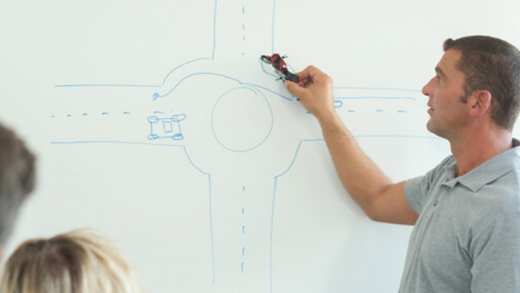So you’ve finally passed your test and you're looking forward to getting out on the road. But as a young driver, the cost of car insurance can seem high.
For a new driver aged 17 to 22, the average cost for a year’s car insurance is up to £1,771 .
But don't worry. Here are our top tips to reduce the cost of your car insurance as a new driver.
Why is new driver insurance so expensive?
One of the main reasons car cover can be costly for young or new drivers is the risk attached to insuring you.
The cost of your insurance is set by actuaries who calculate risk, and underwriters who assess your individual circumstances.
Statistically, 1 in 5 new drivers suffer a crash within 12 months of passing their test. And drivers aged 18 to 21 account for more than 70% of car insurance claims for fully comprehensive cover .
So to an insurer, young or inexperienced drivers are more likely to claim on their insurance – meaning they’re a higher risk to insure. And the higher the risk, the higher the cost of insurance.
What type of car insurance do I need?
Generally, there are 3 different types of car insurance to choose from – Third Party Only (TPO), Third Party, Fire and Theft (TPFT) and Fully Comprehensive.
Third Party Only (TPO)
Third Party Only is the minimum level of cover you can choose. It only covers costs of repair or injuries to a third party following an accident that you cause. It won’t cover any costs to your own car or any injuries you might suffer.
Third Party, Fire and Theft (TPFT)
Third Party, Fire and Theft offers additional cover for any damage caused by fire, as well as costs if your car is stolen or damaged in a theft or attempted theft.
With TPFT, you’ll also start to build up a no claim bonus – so if you don’t make any claims within the year, your insurer will apply a discount to your premium the following year.
Fully Comprehensive
Comprehensive cover is the highest level of cover you can choose. You’ll be insured against any damage to a third party and their vehicle, as well as to your own. So if you’re in an accident that’s your fault, you can still make a claim on your policy.
Choosing your level of cover
Firstly, don’t assume that the most basic cover is necessarily the cheapest. Take a look at the specific details of each policy as well as things like no claim discounts, to find the most suitable cover for you.
Remember too that if you are able to, paying your premium annually (in one go) rather than in instalments can often be cheaper over the course of the year.
Top tips for reducing the cost of your car insurance
Ultimately, you want to demonstrate to insurers that you're less of a risk than the average new driver. Here's a few things you can do to help reduce the cost of your car cover.
Choose a car with a low insurance group rating
Every car made for the UK market is assigned a car insurance group rating of between 1 and 50 by the Association of British Insurers. Ratings are based on things like the value of your car, the security features it has and how much replacement parts cost.
Typically, cars in a lower insurance group will be cheaper to insure than those in the highest group. So it might be more sensible to go for a Fiesta rather than a Ferrari if you want to keep your insurance premiums down.
Check the size of the engine
Statistically, cars with larger engines that can accelerate to high speeds are more likely to be involved in accidents (so are riskier for insurers).
So choosing a car with an engine smaller than 1.4 litres will likely result in lower insurance premiums.
Reduce your mileage
Put simply, the less time you spend on the road and the fewer miles you cover, the less of a risk you pose to an insurer.
Driving only for leisure (and not commuting) is a simple way to reduce the number of miles you cover.
You might not be sure exactly how many miles you’ll cover, but your insurer will still ask for an estimate when you get your quote. Don’t be tempted to tell your insurer you'll do less miles than you realistically think you'll do (as you could invalidate your policy).
Add a named driver to your policy
Having a parent or responsible adult as a named driver on your policy can reduce the overall cost of your policy (as long as they’re safe drivers, of course).
As you’ll be sharing the driving responsibility, the risk is reduced by adding an experienced driver, often resulting in a cheaper premium.
However, if you’re still the main driver of the vehicle, then your policy needs to state this.
Naming a more experienced driver as the main driver (when really, you do most of the driving) is known as ‘fronting’ and is not only illegal, but could invalidate your policy altogether.
Consider a Multi Car policy
If you have 2 or more vehicles at your home address, insuring them all under one policy could reduce your premium – as most insurers offer a discount compared to individual policies.
Most comparison sites aren’t able to show these discounts, so you’ll often need to go to providers directly.
Take a look at our Multi Car insurance to see if you could save on your policy.
Keep your car safe and secure
It’s not just the type of car you have, but where you keep it – and how secure it is – that contributes to your car insurance cost.
Parking your car off the road on a secure driveway or in a locked garage at night can help reduce the risk of your car being damaged or stolen.
Additional security features such as immobilisers, tracking devices and car alarms can also bring down the cost of your policy by making your car less attractive to thieves.
Get extra driving experience with Pass Plus
If you've passed your test within the last 12 months, you could choose to take a Pass Plus course.
Pass Plus is a short, practical training course designed to enhance your driving skills. And it can even help reduce the cost of your car insurance .
The course usually costs around £200 and consists of 6 practical modules taken over the course of 5 and a half hours of driving 3, covering things like:
- spatial awareness when driving in town centres
- rural hazards
- difficult weather conditions
- driving on motorways and dual carriageways
- driving at night
To pass the course, you’ll need either ‘Achieved’ or ‘Exceeded’ grades for each module. And you’ll receive a certificate once you’ve passed the full course.
You can then provide details of your certificate to your insurer and often receive a discount on the cost of your car insurance policy.
Take a look at telematics (or a ‘black box’)
To help insurers get a more accurate picture of how you drive, telematics (or a ‘black box’) can be fitted to your vehicle which records your driving performance.
The black box is about the size of a smartphone and measures things like your braking and acceleration, as well as whether you adhere to speed limits.
Put simply, the more safely you drive, the lower the cost of your insurance is likely to be.


